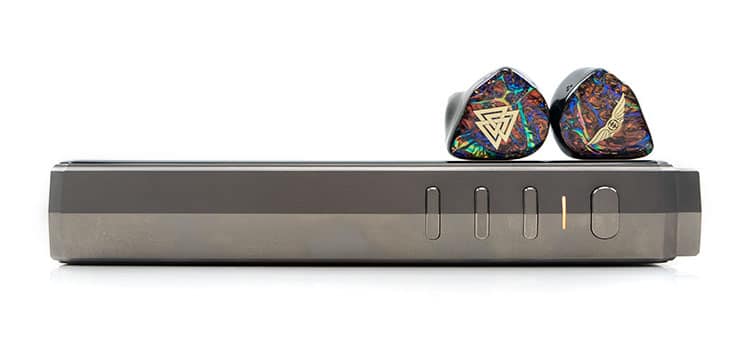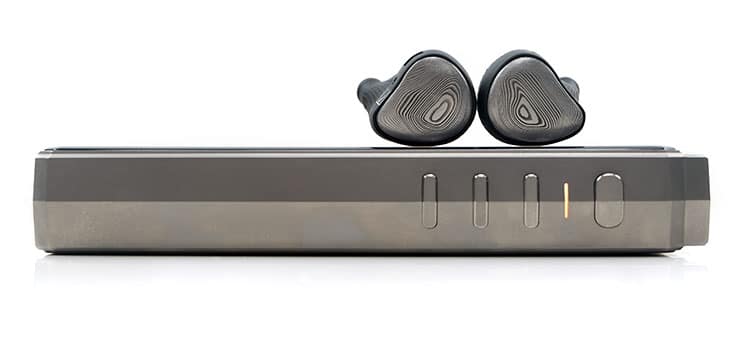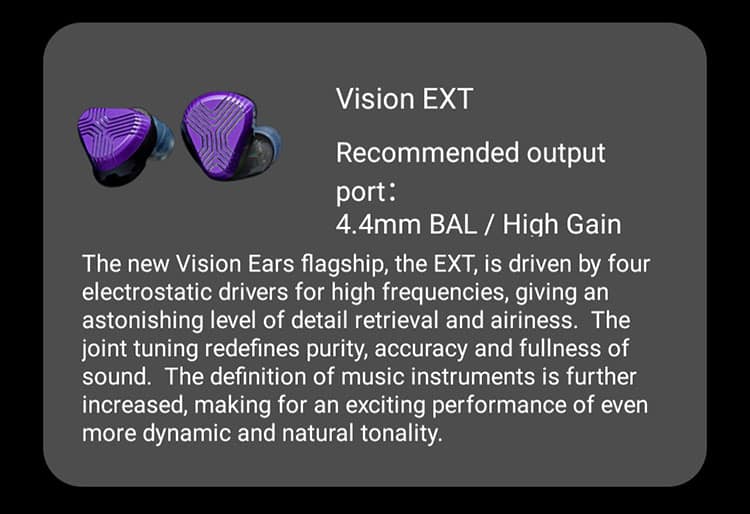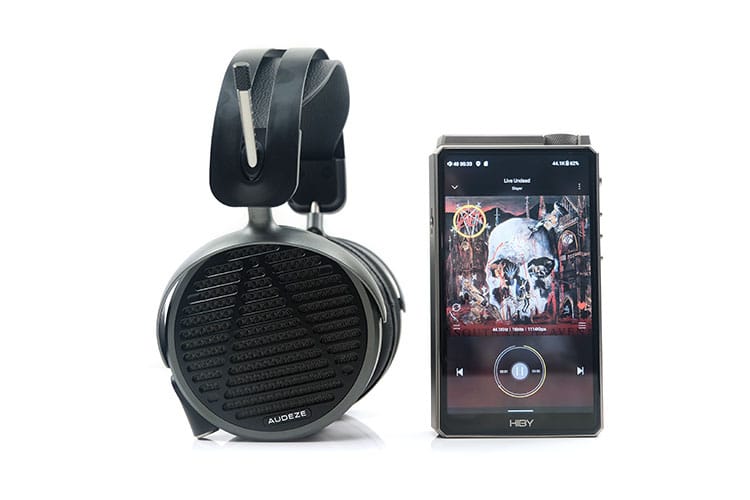Sound Impressions
Summary
The RS8 performance is the most mature DAP tuning HiBy has accomplished to date. It runs the P6 Pro very closely indeed and at times surpasses it and this has been my standard for portable R-2R sound quality for quite some time.
It has a very balanced and natural tone to pretty much all of my tested pairings with the Noble Audio Viking Ragnar in particular sounding gorgeously smooth with oodles of that sought-after R-2R textural detail I always look for in platforms like this.
And yet, it is different in its sound from the P6 Pro and a step up also on the RS6. It is not as warmed up as the RS6, certainly much airier and more expansive sounding also. Neither is it quite as bass and vocal forward or as intimate in its presentation compared to the P6 Pro.
It does retain a healthy level of density though, particularly with Turbo mode turned on with some excellent ‘bounce for the ounce’ with hybrid dynamic driver monitors such as the Empire Ears Odin.
The density does not come at the cost of air either. The layering and instrumental separation from the RS8 is probably superior to the P6 Pro with a stronger lateral emphasis and increased treble presence. It provides some additional depth and 3D dimensional character to the performance.
Despite the 780mW maximum output, a number of headphones will drive quite well from the RS8. The key here is Turbo mode which ups the available voltage headroom delivering some excellent dynamics and lateral expansion. Without Turbo mode headphones such as the Audeze MM-500 sound relatively muted.
Timbre
You have to remember that just because the core DAC is R-2R it does not mean a company is stuck with one sound signature. The opamps and filtering as well as the Darwin controller will still have some effect on the final output, not to mention the pairing you go with.
In this case, the RS8 does exhibit aspects of that core R-2R tone I am looking for in a source. That means paying attention to some gorgeous textured detail, a slightly rounded smooth instrument/vocal delivery, and a treble that is natural sounding rather than digitally perfect.
However, the output also meshes with some classic transistor colorations so you also get that energetic drive with a dense fast action bass performance and not quite the same level of sweetness or atmospheric expansion as something like the tube timbre mode from the N8ii.
The switch from AB to Class A is not huge either so with Class A only marginally smoother but only subtly so. It is not as overt a change as the N8ii Class AB to Class A switch or HiBy’s own Economy mode to Class A on the R5 Gen 2.
Perfectly balanced would be an apt phrase here, neither too heavy on the lows, too intimate and dense in the mids, nor too bright and peppy on the highs. It will not color your IEM performance too much in either direction save for a natural firmness in the lows and a slight deemphasis on leading note edges through the mids.
One final note, go with NOS over OS. It just sounds so much more natural to my ear though treble lovers might appreciate the nuanced additional presence in the highs. However, for me, the denser more robust timbral effect of NOS wins every time, especially with more unforgiving IEMs.
Staging & Dynamics
The RS8 staging is big and complex with some excellent dynamic range and timing. In a way, it reminds me of iBasso’s penchant for delivering airy and spacious elements to their DAPs with a holographic presentation nothing sounding congested, especially through the mids.
It soars over the regular solid-state Class AB mode of the N8ii sounding much more expansive and deeper in its delivery. It also extends wider and taller than the P6 Pro with monitors such as the Ragnar that really do need a source that can fill its arena-like staging quality.
I would say though the mids and bass positioning are a shade more neutral compared to the P6 Pro which perhaps only adds to the perception of increased space from the stage and instruments.
I also tend to keep RS8 Turbo mode switched on for all classes of IEMs and not just headphones for the additional impact it delivers on the low-end as well as giving vocals a more forward and robust dimension. It does wonders in stretching the staging dimensions out even further and delivering an excellent fundamental.
Plug-in’s
I can’t talk about the sound on the RS8 or any HiBy device for that matter without including mention of MSEB and in particular the tuning styles.
You should try these if the Darwin presets are not working for you because they are a little more dramatic in their delivery but it will ultimately depend on the IEM or headphones you are using.
For example, for the Empire Ears Legend EVO, I went for the Hot Monster Output. This is an exciting preset of sorts but it does target some areas that are a pro and cons of the EVO, the bass response, and the vocal presence.
If you want an all-out attack on the lows with enhanced weight and punch then this tuning style is an absolute weapon. The punch and weight, are, well, monstrous, and despite its obvious coloration it actually never loses control or becomes overly bloomed.
A little trick in there seems to be to thin out the note thickness just a shade and introduce some additional crispness and air into the mix to retain a nice healthy contrast in the performance of the EVO. It is a perfect tuning style for the EVO and in turn, both are perfect for sparsely mixed but hard-hitting R’n’B mixes.
Another tuning style I tended to enjoy was Analog, particularly with the likes of the Viking Ragnar. The Ragnar’s highs can be unforgiving if poorly matched. This style works a bit more warmth into the coloration and ups the note thickness at the same time. It also dials down heavily on any potential sibilance with a softer overlay on the highs.
The net result is a slightly shorter level of decay and a smoother leading edge which works better for me when using the Ragnar on percussion happy rock tracks which can sometimes fatigue my ears.
Synergy
Efficiency
I am pleased to say that the RS8 PO output is deathly quiet from both its balanced and unbalanced outputs using super sensitive monitors in low gain mode.
It is quite a difference compared to the R8 performance using something like the Andromeda 2020 or the Solaris SE. Both exhibited a very black background on the RS8 using a low volume setting whereas the R8 has some clear levels of hiss.
Even with Turbo mode on the RS8 low gain setting was extremely quiet. It is only when you go up to high gain without Turbo mode does the RS8 struggles with volume levels not being absolute zero on super-sensitive IEMs.
With Turbo mode you can pick up the audio on medium and high gain levels with sensitive IEMs though quite why you would need that level of power for these types of monitors is beyond me so it’s a largely passive observation.
Power
At a maximum of 780mW balanced from the RS8 you are straddling the fence between good and great power for a DAP. For the size of the RS8, I did expect a bit more, and true enough the R8 did have more nominal power at 1W balanced.
Then again, compared to the N8ii’s max 750mW rating into a 32Ω it is actually a little higher so the glass can be half full or half empty depending on your perspective. It is only really the M17 so far that has exceeded my expectations in terms of high-powered output at 1.5W and 3W with a DC power supply.
Turbo Mode
However, Turbo mode does make a big difference to the RS8’s performance, not just with headphones but also with plenty of good quality IEMs. For example, I found the Noble Audio Viking Ragnar quite smooth and organic sounding when paired with the RS8’s 4.4mm output.
However, with Turbo mode the dynamic range took a huge leap in my book sounding much more impactful on the lows and more intense and vivid through the mids.
The only thing you have to watch out for is the treble which is a little stronger and bleeds a bit more contrast into the mids. That can work well with something like the lush-sounding Vision Ears Phonix but might be more stressful with brighter-sounding monitors.
I much preferred the Turbo Mode with the Viking Ragnar and Empire Ear’s Odin. Both of their dynamic driver low-ends sounded more authoritative and deepened the staging dimension considerably.
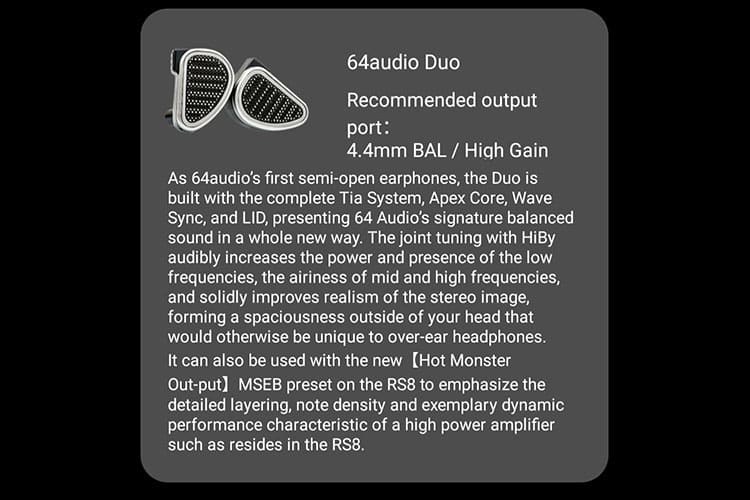
Darwin Controller Presets
HiBy is still positioning the RS8 Darwin tweaks for IEMs-orientated DAP though at some point I would love to see some headphone collaborations given the additional power and Turbo mode.
The Darwin Controller presets do bring a very interesting dimension, and whilst not as overt as MSEB or EQ tinkering, there were some subtle changes in how each IEM was presented once the presets were activated.
I won’t go through every preset in this review but below are a few samples of the changes noted with our tested monitors including 2 new ones, the 64 Audio Duo and the VE EXT.
64 Audio Duo
Just an important reminder that if you love the NOS tuning you are out of luck as the Duo preset only works with the RS8 OS mode option turned on.
Ideally, the Duo preset will increase the low-end presence and improve the top-end headroom in a nutshell. The stock Duo V-shaped tuning is relatively pillowy on the lows with a creamy or warm and smooth-sounding timbre in general.
I found the changes more nuanced than overt but not in-audible if you spend some time analyzing them. My test was done with the 4.4mm balanced output in low gain with Turbo mode switched on.
The key difference in the bass was not just a bit more power but improved articulation and character for me. If you want to enhance the bass more dramatically I would opt for MSEB instead via the HiBy Music App.
The preset bass response sounded tighter, less pillowy, and more distinct in the mix compared to the stock sound. The second difference was for higher pitching vocals that got a little more treble overtone and came out of their shell a bit more.
Perhaps that’s as a result of 64 Audio’s claimed improved airiness in the mids and highs and certainly, they did offer an improved presence and pop compared to the stock tone.
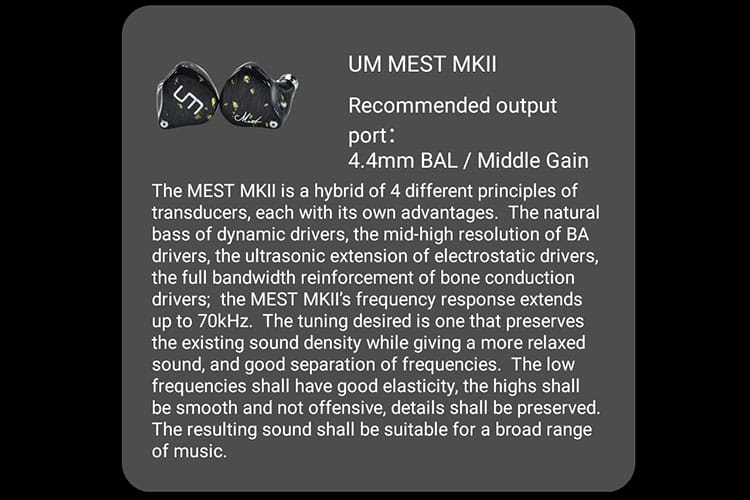
Unique Melody MEST MKII
Just to note this is the custom version of the MEST MKII being tested with the RS8 presets and not the universal version.
I guess the first thing I want to point out is that the definition of this preset is unchanged from the original RS6 preset. The only noticeable quantifiable change is the final high harmonic controller benchmark which is set at 50 instead of 32.
I had a hard time discerning the precise changes on a subjective level with this preset, perhaps more so than with the RS6 version which took a bit of time to figure out also.
The only noticeable difference between the stock performance and the preset was probably in the mids and treble overtone with female vocals and high pitching layered backing vocal banks getting a tiny bit more presence and some sweetened contrast in their timbre.
Turning the preset on and off didn’t alter it so much as shifting the harmonic controller to 50 and then back down to zero. I did find a more noticeable difference in turning NOS on with the atmospheric-enhanced controller at the same time.
Here, the timbre felt a little bit denser through the mids and highs, slightly more liquid and natural in tone. Atmospherics give it a lift also in terms of air and headroom to prevent any perceived dullness in the performance.
Vision Ears EXT
Testing for this was also done via the Balanced PO of the RS8 using the Vision Ears EXT combined with its stock SpinFit tips. Probably one of the most important noticeable changes is this preset actually uses NOS rather than OS with a very high 180 benchmark for the Harmonic Controller.
If you check the description in the image above for the EXT preset there is an emphasis on fullness and natural tonality and generally speaking, NOS will give you that more than the OS alternative on the RS8.
This preset, like the others, is also a nuanced change and it does seem to target the mid to highs a bit more noticeably over the lows. Switching to NOS though gets my vote and it will sound more natural with some additional weight and solidity to the upper mids and high note registers.
Vocals also have a little more presence and clarity. They sound a little flatter in OS without the preset and also a shade thinner with less texture. NOS produces a denser more natural sound for me but the preset adds a bit more lift also and as VE says, gives them a bit more dynamism and excitement in their delivery.
Headphone Pairings
I do recommend most headphones, especially planars, are paired via the RS8 balanced output to get maximum voltage and current and if needed throw on Turbo Mode also to give the presentation an additional dynamic range lift and a more holographic staging quality.
Audeze MM-500
A good example of this is the Audeze MM-500 which is not an inefficient planar and does perform quite well with portable sources with decent power. It can also scale though with improved voltage and current headroom.
It will sound reasonably powered on the medium gain setting from the 4.4mm balanced output from the RS8 but the overall dynamics sound like they are quite reserved despite hitting the required volume level. Smooth, decent width staging but with moderate depth and not a huge amount of treble presence overall.
Turbo mode changes things beautifully. The entire tuning comes to life with far more bass presence and most definitely upping the dynamic range level and creating a stronger 3-dimensional quality.
The vocals do pop out a lot better here sounding much more immediate. Whereas with the non-Turbo mode, you struggle to get into them, and yes, treble has increased presence and perceived clarity giving you a much more ‘filled in’ and complete presentation.
T&A Solitaire P
The 80Ω 100dB SPL T&A Solitaire P is probably right on the limit of what the RS8 can drive to a reasonable level and it’s a very clear-cut example of why Turbo Mode can make a big difference to headphone performances.
Without Turbo mode, you need a high gain level and a volume of about 80 to get any decent loudness out of the Solitaire P performance. It does sound smooth but quite reserved in dynamics and is too soft on the highs also.
Now I know the Solitaire P has some strong highs when called upon and some might enjoy the smoother tone, especially in Class A. However, this is too smooth with a midrange that is quite flabby and lacking in engagement.
With Turbo Mode on the midrange veil is lifted with improved highs, a stronger vocal presence, and an improved treble presence.
I would argue the low-end is just a little on the soft side compared to a full-scale high-powered amp such as the 6W-capable Feliks Audio Envy and you do need to keep it on high gain high volume to drive it but it’s a vast improvement from the muted dynamics from the non-Turbo mode performance.


